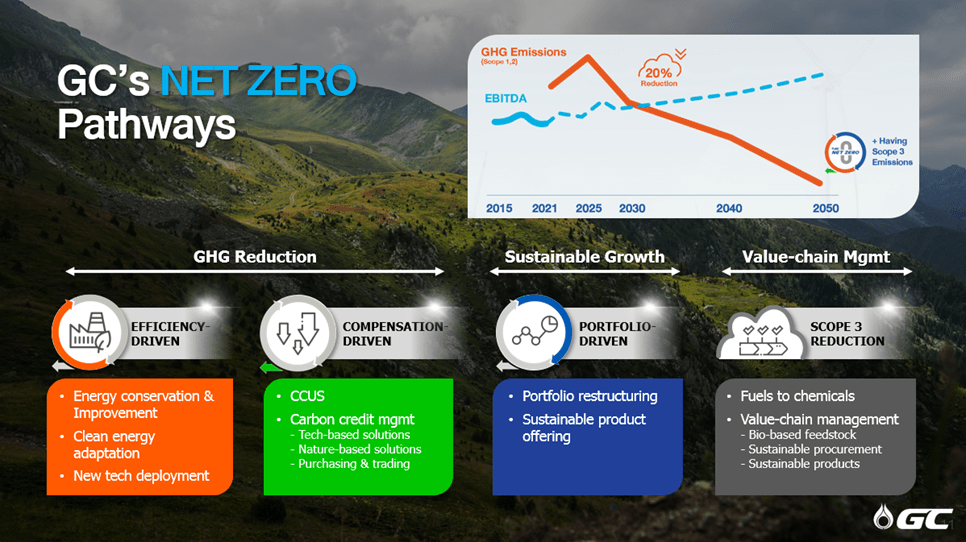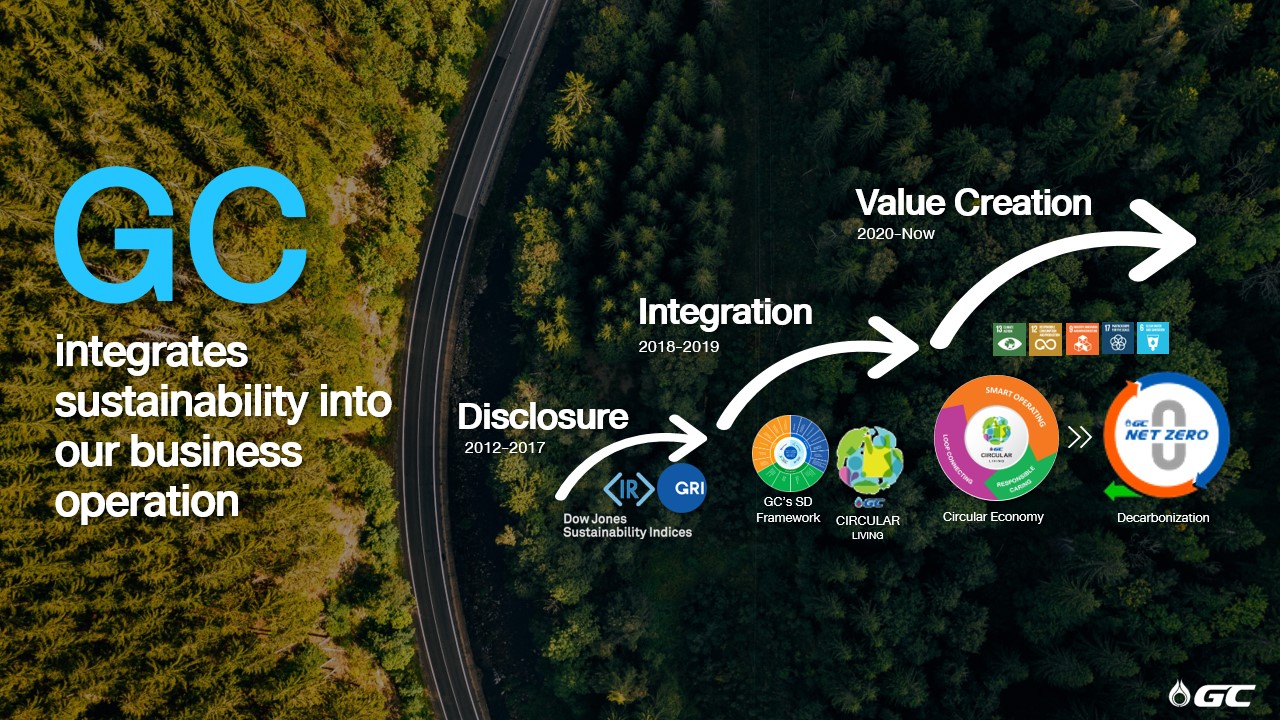Climate Change Strategy and Target
Target
- Reduce greenhouse gas emissions (Scope 1and 2) more than 20% by 2035 and reduce greenhouse gas emissions (Scope 1 and 2) to net zero by 2050.
- Reduce Scope 3 emissions by 50 percent by 2050.
(update as of October 2025)
Challenges and Opportunities
Climate Change is a critical issue that has garnered attention from all sectors at both national and global levels. These challenges significantly impact business continuity, encompassing physical risks such as flooding, droughts, and severe storms, as well as transition risks stemming from regulatory enforcement. Such risks lead to increased costs in production, raw material access, and compliance. GC recognizes the potential impacts of these challenges on both internal operations and external stakeholders. Therefore, it places high importance on effective greenhouse gas (GHG) management to reduce cost-related risks, meet the expectations of environmentally conscious consumers, and strengthen credibility among investors. This approach also aligns with national commitments and the goal of achieving net-zero greenhouse gas emissions.
Management Approach GRI 3-3 GRI 3-3 (2021)
Climate Strategy
GC has established both short-term and long-term strategies for energy management and climate change in accordance with the International Financial Reporting Standards (IFRS) S2: Climate-related Disclosures. Our climate change action plan focuses on enhancing the production process, energy management and energy conservation to achieve optimal efficiency. We also consider the possibility of utilizing alternative energy to uplift our performance in greenhouse gas reduction while planning to expand the scope of operations to incorporate scope 3 value chain emissions.
GC is committed to implementing Thailand’s Long-Term Low Greenhouse Gas Emission Development Strategy (LT-LEDS), while simultaneously pursuing new business growth. This commitment is guided by three strategic approaches:
- Decarbonization: reducing greenhouse gas emissions through three key operational areas:
- Efficiency-Driven: Enhancing Operational Efficiency.
- Portfolio-Driven: Adjusting the Business Portfolio Towards High Value–Low Carbon Ventures.
- Compensation-Driven: Offsetting carbon to manage residual greenhouse gas from production processes and business operations.
- Sustainable Product
- Hydrogen-Carbon Business

“GC’s Decarbonization Pathways”

“GC integrates sustainability into our business operation”
GC has defined unequivocal management guidelines and medium-term goal to cut down greenhouse gas (scope 1 and 2) emissionsmore than 20% by 2035 This is part of the process towards achieving net-zero emissions in 2050 and is in line with the Paris Agreement. Accordingly, GC supports and encourages customers and suppliers to participate in the endeavor to accomplish such a goal. Moreover, the company is committed to conducting business through cooperation and engagement with various organizations around the world to maximize operational efficiency. GC has incorporated stakeholder engagement into the low carbon pathway framework as it coincides with the goals of the Paris Agreement and can also stimulate the accomplishment of the low-carbon business goal.
GC has set climate-related targets and Key Performance Indicators (KPI) to monitor GC’s performance and support global ambition to reduce effect caused by climate change. Hence, GC’s climate-related target has set in accordance with national and global targets, for instance, Thailand’s Nationally Determined Contribution (NDC), Paris Agreement in the 26th Sessions of the Conference of the Parties to the United Nations Framework Convention on Climate Change (COP26) and Sustainability Development Goals (SDGs), which emphasis on reducing greenhouse gas emission from its operations by enhancing energy efficiency and encouraging alternative energy. These are aligned with the Sustainable Development Goal 7: Affordable and Clean Energy (SDG 7), and Sustainable Development Goal 13: Climate Action (SDG 13) of the United Nations, as well as Carbon Disclosure Project (CDP).
(UN SDG 7: Affordable and Clean Energy)
(UN SDG 13: Climate Action)
To achieve the mentioned target, GC has analyzed internal and external risk factors, which may affect the business operation in both short-term and long-term. Additionally, GC monitors the Emerging Risks from the Early Warning System to identify climate change risks that may cause widely impacts on GC and/or industry over the next three to five years. Therefore, GC has established risk and crisis management approaches to manage risk within an acceptable limit in response to GC’s Climate Strategy.
Climate-related Performance GRI 305-1 (2016,) GRI 305-2 (2016), GRI 305-3 (2016), GRI 305-4 (2016), GRI 305-5 (2016)
Organizational Greenhouse Gas Inventory
GC has established organizational greenhouse gas inventory based on ISO 14064-1:2018, the Greenhouse Gas Protocol, American Petroleum Institute (API 2009), Intergovernmental Panel on Climate Change (IPCC) 2006 and Thailand Greenhouse Gas Management Organization (Public Organization)/TGO in order to serve as a greenhouse gas management guideline and to regularly report organizational greenhouse gas emission. The company has also disclosed information in accordance with guidelines of the International Financial Reporting Standards S2 (IFRS S2) Climate-related Disclosures, which cover four key aspects: 1) Governance, 2) Strategy, 3) Risk Management, and 4) Metrics and Targets, as well as in responding to the Climate Change Questionnaire conducted by the globally recognized sustainability assessment institute, CDP Climate Change.
Furthermore, GC has collected greenhouse gas emissions data from other related activities (scope 3) according to the Technical Guidance for Calculating Scope 3 Emissions of the GHG Protocol. This leads to the management of greenhouse gas emissions throughout the supply chain. GC has evaluated 9 activities, and other related activities within Scope 3 of greenhouse gas emissions from below nine categories.
Greenhouse Gas Emissions (Scope 3)
| Activity | Emission (tons CO2 equivalent) |
|---|---|
| Purchased Goods and Services | 5,872,136 |
| Capital Goods | 121,552 |
| Fuel and Energy Related Activities | 1,277,531 |
| Upstream Transportation and Distribution | 580,966 |
| Downstream Transportation and Distribution | 35,726 |
| Processing of Sold Products | 3,608,576 |
| Use of Sold Products | 25,989,989 |
| End-of-life Treatment of Sold Products | 1,076,756 |
| Investments | 1,593,811 |
The GC Greenhouse Gas Report related to direct GHG emissions and energy indirect GHG emissions and other indirect GHG emissions are assurance by the third party verification in accordance with the ISO 14064-1.
Internal Carbon Pricing
GC has applied the Internal Carbon Price (ICP) mechanism to assess the impact of carbon on our projects. This is used to support our investment decision by ensuring that projects that GC invests in can generate returns according to established goals in the long run. The ICP is implemented together with the Marginal Abatement Costs Curve (MACC) to make investment decisions on greenhouse gas reduction projects and assist GC in accomplishing the Net Zero Target by 2050. Furthermore, GC also implements internal carbon pricing for various purposes. Highlight projects include:
Evaluation of the project on CO2 pipeline installation from Ethylene Glycol plant to customers
Pushing for low-carbon projects which are applied as the shadow price in making investment decisions on solar and wind power projects
Establishment of an ad hoc task force to coordinate with PTT Group to develop and support the use of internal carbon prices among organizations
Through the outstanding implantation of GHG reduction programs, GC can continuously reduce GHG emissions as follows;
Greenhouse Gas Emissions (Scope 1 & 2)
| Performance | ||||
|---|---|---|---|---|
| 2021 | 2022 | 2023 | 2024 | |
| Greenhouse gas emissions (Million tons CO2 equivalent) |
8.55 | 8.18 | 7.96 | 7.82 |
2024 Target
Greenhouse gas emissions
million tons CO2 equivalent
More information on other highlight projects of climate change is available in GC Integrated Sustainability Report 2024, such as
- Efficiency-driven: Enhancing process efficiency through projects such as Energy Conservation Project, Recovery Heat from Benzene Rundown, Heavy Aromatic Overhead, Gas Turbine Generator’s Advance Gas Path (AGP) Improvement, Optimization Compressor by Tuning Surge Control Line, Renewable Energy, Solar Energy and Biogas.
- Portfolio-driven: Adjusting the business portfolio through projects, such as the world class recycled plastic pallets through ENVICCO Ltd., the GC YOUTURN Platform, the global leader in Biodegradable Plastic Pellet Production through NatureWorks, the world leader in Eco-friendly Industrial Coating Resins through allnex and Sustainable Aviation Fuel (SAF).
- Compensation-driven: Offsetting carbon by studying and implementing projects such as Carbon Capture and Storage (CCS) Study in collaboration with PTT Group, Framework for Industry’s Net-zero Transition and Nature-based Solutions.